 Every day in the UK there are millions of pallets being stacked with a wide variety of products. Estimates suggest that as much as 50-60% of this process is undertaken by hand. This is yet another reflection of how far behind the UK currently is in terms of adopting automation and robotics, and in many cases people are unaware of the current technologies available that could add tangible benefits to their business.
Every day in the UK there are millions of pallets being stacked with a wide variety of products. Estimates suggest that as much as 50-60% of this process is undertaken by hand. This is yet another reflection of how far behind the UK currently is in terms of adopting automation and robotics, and in many cases people are unaware of the current technologies available that could add tangible benefits to their business.
To help you get a clearer understanding, we have put together this article as an introduction to automated pallet stacking and the key things to consider if you are thinking about investing in automation.
What is palletising?
Palletising is the process of placing or stacking goods onto a pallet or pallets.
Over the years palletising has developed from being entirely reliant on manual labour, to the introduction of automated machinery to place products onto pallets in preparation for their despatch. Efficient palletising of products is an essential part of the supply chain as it ensures the production process is leaner and more efficient. Automated palletising systems can also be designed to include the dispensing of slip sheets onto the pallet, either in-between the various product layers, or on top of the finished load.
Automatic pallet feeding can also be included in a robotic palletising system. Automated pallet feeding works in tandem with the production to keep the production line running continuously.
What are the advantages of automated pallet stacking?
- Less downtime – The palletising process can continue for as long as needed, without requiring any breaks as with manual staff.
- Lower health and safety risks – Staff members are removed from potentially risky jobs that can lead to repetitive strain injuries or other potential injuries.
- Higher staff morale – A traditionally labour intensive job is removed from the schedule which improves worker’s morale and work enjoyment.
- Faster production speed – With less downtime and more pallets stacked it will positively impact the overall speed of the entire production line.
- Better pallet stack alignment – Automated stacking ensures the goods are positioned accurately in the correct position, improving safety.
- Less product defects – Poor stacking can create imbalanced weight and damage to both pallets and products which automated stacking avoids.
- Multiple solutions – One automated pallet stacking system can be used on a range of product lines regardless of their size, shape and dimension.
Typical payback calculation for an automated pallet stacking system
Click here to download our excel payback calculator with typical payback calculations, enter your full production details to see what the payback could be for you.
Risks of using automation and how to overcome them
- Product dimensions can frequently change along with the size of the pallets required to carry them which means that automated palletising systems have to be re-programmed at a cost. To avoid lengthy delays and expensive re-programming costs, invest in an automated pallet stacking system that can be re-programmed quickly and easily without you having to call in an external engineer on every occasion.
- One of the advantages of installing an automatic pallet stacking machine is it will reduce production time but this needs to be monitored carefully. Whilst it will always be faster than one person doing the job, it may not be more efficient than two or three workers. Take this into consideration when assessing how it will impact the production line and facility resources.
- The gripper used on an automatic pallet stacking machine is one of the most important elements to consider. Choosing the wrong one can have significantly bad consequences for your product as the wrong fit could damage the goods. Test the product with the gripper before buying and rolling it out across the entire production. Book a FREE trial of your product on a Granta palletiser today.
- If you are stacking products in bags onto pallets, this may lead to poor stacking quality when it is done automatically. The way to avoid this is to work with a system that allows you to pre-prepare the product. This means when it comes to being stacked by the automated process it is done correctly without any damage being caused to the pallet or the product.
- To avoid an extended period of time between the changeover of products where cycle time is critical, make sure the system is fully automated with automatic pallet feeding.
Conclusion
 Introducing automatic pallet stacking into your facility will dramatically improve the efficiency of your production line thanks to the many benefits it brings. In the vast majority of cases this can be felt with immediate effect, ensuring you see a tangible return on investment which enables you to recoup your outlay in a relatively short space of time.
Introducing automatic pallet stacking into your facility will dramatically improve the efficiency of your production line thanks to the many benefits it brings. In the vast majority of cases this can be felt with immediate effect, ensuring you see a tangible return on investment which enables you to recoup your outlay in a relatively short space of time.
Whilst there can be some initial challenges to overcome, this can be effectively managed by choosing a specialist automation company that will work with you to find a solution that matches your needs.
Try your products on a palletiser for FREE, book now!








Warning: Undefined variable $aria_req in /var/www/granta-automation.co.uk/news/wp-content/themes/twentyten/comments.php on line 81
Warning: Undefined variable $aria_req in /var/www/granta-automation.co.uk/news/wp-content/themes/twentyten/comments.php on line 86